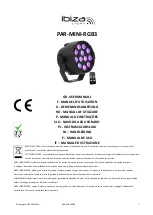
23
Subject to change without notice
In the fastest time base settings of 2 ns/cm one period of a 125
MHz signal is displayed with a length of 4 cm.
Maximum signal frequency in digital mode
The highest signal repetition frequency which still can be
displayed well cannot be exactly given. It is dependent on the
signal shape as well as on its display amplitude.
While it is fairly easy to recognize a square wave, it requires at
least 10 samples per period to distinguish a sine wave from a
triangle. In other words, in practice, signals may still be reco-
gnized if their frequency is <1/10 of the sampling frequency,
so that a minimum of 10 samples per signal period should be
present.
As to be seen from the readout, the maximum sampling is due
to the deep memory, present over a wide range of time base
settings and so is the highest possible frequency that can be
sampled with 10 samples per period.
Display of aliases
The following description is only of importance if the display
modes “Dots” or “Vectors” have been chosen in the SETTINGS
menu “Display”. As mentioned before aliasing is nearly impos-
sible in “Optimal” display mode, but it must be noted that this
display mode shows the maximum noise on a signal.
Display in “Dots” or “Vectors” mode.
If due to the current time base setting the sampling rate is too
low (in respect of the signal to be sampled) aliasing may result.
The following example describes this effect.
A sine wave signal may be sampled with one sample per period.
If all samples are taken randomly at the sine wave positive peak
value, the display of the samples shows a straight line in the
position of the positive peak value and consequently suggest a
positive DC voltage.
An alias may also take the form of a signal of much lower
frequency (beat frequency between signal and sampling fre-
quencies), apparently untriggered changing display and may
look like AM modulated signals. If an alias is suspected, change
the signal frequency, the time base or both. If aliases remain
undetected grossly erroneous results will be obtained which
also include grossly (maybe orders of magnitude) false displays
of signal parameters like rise time etc.!
The best method to detect any false digital oscilloscope display
is to switch to analog mode. In analog mode false displays are
absolutely impossible! An analog scope can at worst round the
edges of very fast signals.
Vertical amplifier operating modes
In principle, in digital mode there are the same modes available
as in analog mode, i.e.:
– CH1 only
– CH2 only
– CH1 and CH2 in dual trace mode Yt or XY
– Sum
– Difference
The main differences of digital mode are:
– In dual channel mode both channels and signals are a/d
converted simultaneously. No alternate or chopped channel
switching.
– No flickering display even with low frequency signals as
the signals are stored and continuously displayed from the
memory with a sufficiently high rep rate.
– Trace intensity is always the same. This can be an advantage
and a disadvantage:
All so called Z axis (trace intensity) information is lost. In ana-
log mode the intensity depends on the signal rep rate and the
speed, thus mixed or unstable signals can be differentiated by
their respective trace intensity. Fast slopes of low frequency
signals are invisible in analog mode, in digital mode they will
be shown as bright as the other signal portions.
C o m b i S c o p e
















































